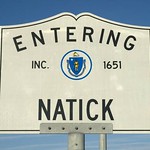Stimulating drug, informally / WED 1-17-24 / Bit of traditional Polynesian attire / Subject of a hairy hoax / Potter's area of expertise / Question often preceded by "But ..." / Product once advertised with the slogan "Everything you love about coffee without everything you don't" / Accelerated path of advancement
Wednesday, January 17, 2024
Constructor: Morton J. Mendelson
Relative difficulty: Easy-Medium
Theme answers:
- FAS[T / T]RACK (1A: Accelerated path of advancement)
- SPLI[T T]ICKET (5A: Ballot with votes for multiple parties)
- HOL[D / D]EAR (10A: Cherish)
- GRAS[S / S]KIRT (35A: Bit of traditional Polynesian attire)
- TEASE[R / R]ATE (28A: Promotion for a new credit account, maybe)
- PE[P / P]ILL (32A: Stimulating drug, informally)
- BULLE[T / T]RAINS (47A: Ultra-rapid transit options)
- STRI[P / P]OKER (53A / 57D): Game that everyone but one person barely loses?) ("barely" here = "nakedly")
Sanka is a brand of instant decaffeinated coffee, sold around the world, and was one of the earliest decaffeinated varieties. Sanka is distributed in the United States by Kraft Heinz. // Decaffeinated coffee was developed in 1903 by a team of researchers led by Ludwig Roselius in Bremen, Germany. It was first sold in Germany and many other European countries in 1905–1906 under the name Kaffee HAG (short for Kaffee Handels-Aktien-Gesellschaft, or Coffee Trading Public Company). In France, the brand name became Sanka, derived from the French words sans caféine ("without caffeine"). The brand came to the United States in 1909–1910, where it was first marketed under the name "Dekafa" or "Dekofa" by an American sales agent. // In 1914, Roselius founded his own company, Kaffee Hag Corporation, in New York. When Kaffee Hag was confiscated by the Alien Property Custodian during World War I and sold to an American firm, Roselius lost not only his company, but also the American trademark rights to the name. To re-establish his product, he began to use the Sanka brand name in America. [...] The intensive American advertising campaigns included the 1927 broadcasts of Sanka After-Dinner Hour (or Sanka Music, Sanka After-Dinner Music, Sanka Music Hour, and Sanka After-Dinner Coffee Hour), heard at 6:30 pm Tuesdays on New York's WEAF. Sanka was a sponsor of I Love Lucy, The Twilight Zone, and The Andy Griffith Show during their respective runs on CBS television in the 1950s and early 1960s. The Andy Griffith Show Sanka sponsor spots featured the cast members. It was also a sponsor of The Goldbergs (1920s to about 1960 on radio and television, unrelated to the U.S. 2013 ABC television series) where, on many episodes, Mrs. Goldberg (Gertrude Berg) would address the camera and talk to the TV audience and tell them about Sanka coffee. After the sales pitch, she would walk away, usually from the window, and start the show. // With such promotion, Sanka became a nationwide sales success, with General Foods Corporation taking over distribution in 1928 as a defensive measure, since Sanka directly competed with its noncaffeine coffee substitute Postum. The bright orange label that made Sanka easily identifiable to consumers found its way into coffee shops around the country in the form of the decaf coffee pot. Coffee pots with a bright orange handle are a direct result of the American public's association of the color orange with Sanka, no matter which brand of coffee is actually served. Businesses that serve rival Folgers decaffeinated coffee usually have green-handled pots. (wikipedia) (my emphasis)
• • •
[THE CYRKLE! Put that in your grid and smoke it!]
Further, the fill is mostly stale, from the era when people drank SANKA and called uppers "PEP / PILLS." Some of it is solid, adequate, innocuous stuff (ASK AFTER, KEPT FIT), but it's hard to get excited about plural LEGATOS or the oddly formal, not-quite-a-square-dance-move "DO AS I DO" or the mid-century befuddled-by-abstract-expressionism query "IS IT ART?" That clue says [Question often preceded by "But ..."] but "often" is doing a lot of work there, since no one who is not in a New Yorker cartoon has asked that question since 1970. Sigh. The fill is not terrible, but it's not good either. Lots and lots of the short familiar stuff. A real A-ONE ODIE grid. I liked the colloquiparadoxical "YEAH, NO," but sadly, "YEAH, NO" is pretty much how I felt about the puzzle as a whole.
The theme was easy to pick up. Here I am, picking it up:
- 39D: Bend the truth, say (TELL A FIB) — I frequently TELL A FIB right after I EAT A SANDWICH. It's a weird tic I have (seriously, why wasn't this TELL A LIE, which at least has some claim to standalone status?)
- 67A: Silently acknowledge (NOD AT) — I think a better clue here would have been [Possible response to a dis?]
- 18A: Potter's area of expertise (MAGIC) — classic "hide-the-capital-letter" trick (put the capitalized word first and it doesn't register as a proper noun)
- 15A: Pre-nursing homes? (UTERI) — because babies (who frequently "nurse") have their "homes" in UTERI ... before they are born ... so, "pre-nursing." Stop me if this gets too recondite for you.
- 50A: Orcinus ___ (marine species) (ORCA) — cannot decide if this is stupid or brilliant. The clue basically gives you 75% of ORCA in the first clue word, making you (me) think ... "well, there's no way it's gonna be ORCA then." Stupid/brilliant!
- 8A: Kind of terrier (IRISH) — had the "H," wrote in WELSH. Weird that both my wrong terrier and the correct terrier were nationalities of the British Isles.
 |
| [sad, omitted WELSH terrier] |
- 64D: Kilmer of Batman fame (VAL) — maybe to you, but to me he will always be [Kilmer of "Real Genius" fame]
[1985, d. Martha Coolidge! Filmed largely on location at Pomona College, chirp chirp!]
[Follow Rex Parker on Twitter and Facebook]
.png)























